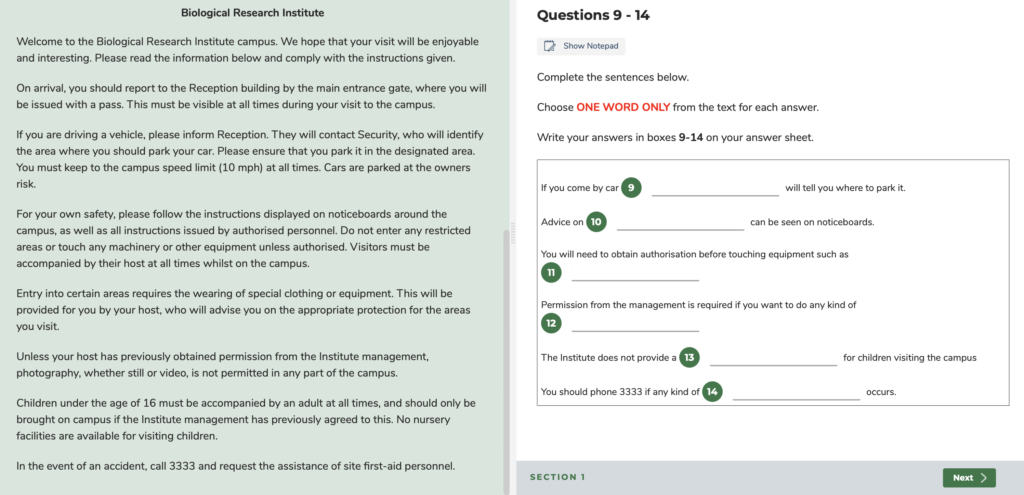People either love or absolutely hate Fill in the gaps in IELTS Reading (FITGs). It’s understandable because well…they are either very easy or very complicated. And you are either very confident with your answers or certain that you’ve got wrong answers but you don’t know what the correct ones are.
So, I’m here to help. It’s great if you love FITGs but if you hate it, this is everything you need to know about FITGs.
What are Fill in the Gaps in IELTS Reading?
This is a Detailing form of question. FITG questions in the IELTS General Training Reading exam require you to complete a passage with the missing words, in other words, the missing pieces of information. The words are usually taken from the text to form sentences that make sense. You can write the answers in all capitals or lowercase.
There are four key elements of FITGs.
- The missing words are always keywords.
- Most possible answers: nouns, verbs, adjectives, names, and numbers.
- Less possible answers: adverbs.
- Impossible answers: pronouns, prepositions, and conjunctions.
FITGs can appear in all three parts of the IELTS GT Reading test at varying levels of difficulty.

Tips
- DO NOT exceed the number of words allowed for each gap. If two words are allowed, you can write one word or two words, but not three words. If you write three words, the answer is considered incorrect.
How many words for “fill in the gaps” questions in IELTS Reading?
- Put the same words that you see in the texts in the gaps. No change is needed. The grammar in the question always matches the grammar of the correct answer (correct word). For example, if you see “colors” in the text and determine that “colors” is the correct answer, put the exact word (“colors”) in the gap. There is no need to think about the grammar.
- Understanding what type of word (noun or verb, for example) is needed for the gap can help you eliminate incorrect answers, but it is not absolutely required. For example, if you’re debating between “colors” (a noun) and “beautiful” (an adjective) for the answer to a gap, but the gap requires a noun, “beautiful” is out. As a result, you can rule out “beautiful” as a possible answer.
- Depending on the context of the question, you can eliminate the incorrect words. As a result, even if you do not understand grammar, you can still find correct answers.
- Both American spellings and British spellings are accepted.
American or British spelling in IELTS Writing?
- Always check your spelling after finishing the questions. Correct words with wrong spelling are still considered wrong answers.
Step-by-step strategy
Step 0: Look at the questions and identify the type of questions.
Step 1: Read and memorize the first TWO questions.
Highlight keywords but keep in mind that these words may not appear in the text, instead, they may be replaced with synonyms.
Memorize the meanings of the questions.
Step 2: Read the text and find the answer to the first question.
Start reading from the beginning or from what is left of the text. If these are the first questions of the first group of questions, read from the beginning of the text. If these are the first questions of a second or third group of questions, continue reading from where you left off.
In most cases, the first answer will come first, followed by the second. If the second answer comes first, one of these two things could have happened: you’ve missed the first answer, or the answer is coming right after this. In this case, you must return to look for the first answer. If you still cannot find it, it means you will not be able to find it there. So, you should keep reading.
Remember to mark the “location” of each answer, that is, which line and paragraph the answer belongs to.
Step 3: Reread the unanswered question and read the third question.
If you have already found the first answer, you should go back and reread the second question to refresh your memory. If you have found the second answer, you should go back and read the first question.
Highlight keywords and the meaning of the third question. Prepare for synonyms.
Step 4: Continue reading where you left off and mark the “locations” of answers.
Step 5: Reread unanswered questions and read the next question after one question is done, until the last question.
Step 6: Check spelling and word limit.
Fill in the gaps are discussed in detail with exclusive practice exercises in our Everything IELTS – The Comprehensive Guide to IELTS.
This Guide is available for free ONLY for members of Everything IELTS Packages. Check out our packages below.
Struggling with IELTS Reading and need more personalized guidance? Book a Consultation Call with me.











Responses